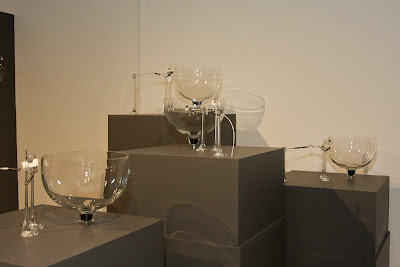 |
| Paula Haymond. Texas Wetlands, 2012. Mesquite, turned, carved, pierced and wood burned. Photo by HCCC. |
 |
| Paula Haymond. Sea Creatures, 2012. Texas ebony, turned, carved, pierced and textured. Photo by HCCC. |
Tell us a little about the current body of work.
I find myself going in multiple directions with a focus on altering the wood, which is initially turned on the lathe, into forms using texture, pyrography, piercing and air brushed paints to create either pictures or creatures. My pictures often involve garden scenes with butterflies, hummingbirds and dragonflies, with floral designs pulling the story together. My creatures appear somewhat alien or anthropological with carved appendages. I like using the wood as a canvas but try to create a relationship between the piece and the viewer so that their natural curiosity draws them in closer to find hidden surprises in the pieces. What drew you to wood as your medium of choice?
I have always been drawn to wood as a property for building objects, but it was the lathe that changed my relationship from hobbyist to artist. I like the wide variety of woods that are available to turn, as well as the many possibilities that I find inspiring in the grain and figure of each piece of wood. Even when I intend to cover the surface with my designs, I first take into consideration what that piece of wood will support and how I will work with it to create something new.
How would you describe your work?
I see my work as dynamic and changing. I love variety and am, for better or worse, always looking for a new angle on creating images which have an impact on the viewer. I like to create the illusion of the wood being some other type of material, such as metal or ceramic. When the viewer says “wow,” or “that really looks like ceramic,” I think I have captured their imagination and they are intrigued by what I have created. I like to encourage them to pick up pieces and really relate to them.
Every piece I create starts on the lathe. If the wood is light colored, then I am more likely to want to use acrylic transparent airbrush paints along with creating a background of textures, lace work, and pyrography. I use a high-speed dental drill to accomplish the lace work and then a variety of burs to create textures. I often either draw or transfer images onto frisket or directly to the wood to cover the piece in a revolving set of images to pull the images together. When I carve, I use an NSK micro motor with burs, sandpaper, and cutters to remove wood quickly. Most of my pieces have hours of hand work involved in them to reach the final three-dimensional objects.
Many of your pieces include color pigment designs. Have you always used color in your work?
No, I started out as a purist, calling on the natural beauty of the wood to be the only dimension I was interested in showing off. I think most wood turners start with the idea that the beautiful wood is all one needs to create enjoyment. Although that can be true, for me, I needed to become more involved in what was happening to the wood beyond the lathe. I have a vivid imagination, and I was able to see characters in the grain of the wood, which I wanted to accent, and that lead to carving away the parts of grain that clouded the images I saw. Carving away wood just lead down a path of further exploration, and I still seek out new ways to add to the character of wooden objects.
 |
| Paula Haymond. Butterfly Garden, 2012. Silver maple, turned, pierced, air brushed and textured. Photo by HCCC. |
What types of wood do you work with? Is there a particular kind you prefer, and why?
Currently I am turning more green wood than kiln-dried wood. In the Houston area, I really find silver maple, magnolia and hackberry to be great woods for turning thin-wall vessels. By thin, I mean less than 1/16th of an inch in thickness. This allows for piercing with the dental burs, which are the same burs the dentist uses to take out cavities. Much thicker walls on the vessels and the bur is not able to cut all the way through the wood at once. I am also exploring turning green mesquite and Texas ebony, which are very dense hardwoods. They are very easy to carve and texture, despite their hardness. They also hold up to the thin-wall turning I do. Because of their strong grain patterns, they do not lend themselves to coloring.
What are you doing when you’re not creating works of art from wood?
I am a licensed psychologist and am still running a practice in Katy. We focus on carrying out psychological and neuropsychological assessments for the Department of Assistive and Rehabilitative Services, as well as for Social Security Disability. Currently, I am working seven days per week while in the AIR program. It continues to be a fabulous opportunity for me.





